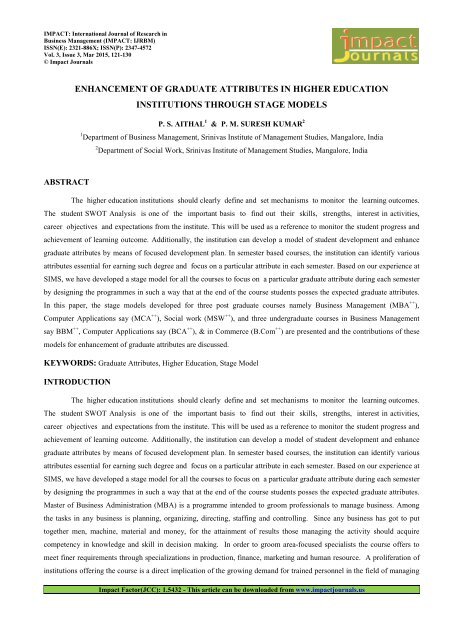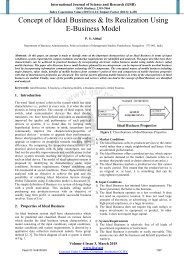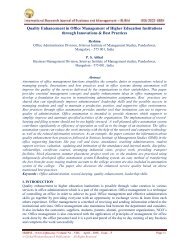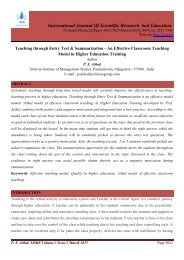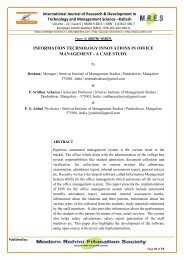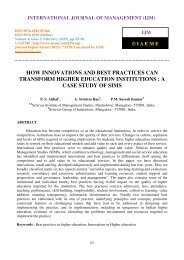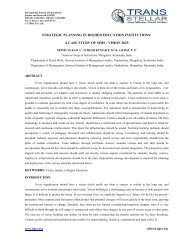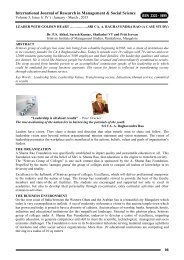Enhancement of Graduate attributes in Higher Education Institutions through Stage Models
The higher education institutions should clearly define and set mechanisms to monitor the learning outcomes. The student SWOT Analysis is one of the important basis to find out their skills, strengths, interest in activities, career objectives and expectations from the institute. This will be used as a reference to monitor the student progress and achievement of learning outcome. Additionally, the institution can develop a model of student development and enhance graduate attributes by means of focused development plan. In semester based courses, the institution can identify various attributes essential for earning such degree and focus on a particular attribute in each semester. Based on our experience at SIMS, we have developed a stage model for all the courses to focus on a particular graduate attribute during each semester by designing the programmes in such a way that at the end of the course students posses the expected graduate attributes. In this paper, the stage models developed for three post graduate courses namely Business Management (MBA++), Computer Applications say (MCA++), Social work (MSW++), and three undergraduate courses in Business Management say BBM++, Computer Applications say (BCA++), & in Commerce (B.Com++) are presented and the contributions of these models for enhancement of graduate attributes are discussed.
The higher education institutions should clearly define and set mechanisms to monitor the learning outcomes. The student SWOT Analysis is one of the important basis to find out their skills, strengths, interest in activities,
career objectives and expectations from the institute. This will be used as a reference to monitor the student progress and
achievement of learning outcome. Additionally, the institution can develop a model of student development and enhance graduate attributes by means of focused development plan. In semester based courses, the institution can identify various
attributes essential for earning such degree and focus on a particular attribute in each semester. Based on our experience at SIMS, we have developed a stage model for all the courses to focus on a particular graduate attribute during each semester
by designing the programmes in such a way that at the end of the course students posses the expected graduate attributes.
In this paper, the stage models developed for three post graduate courses namely Business Management (MBA++), Computer Applications say (MCA++), Social work (MSW++), and three undergraduate courses in Business Management
say BBM++, Computer Applications say (BCA++), & in Commerce (B.Com++) are presented and the contributions of these models for enhancement of graduate attributes are discussed.
Create successful ePaper yourself
Turn your PDF publications into a flip-book with our unique Google optimized e-Paper software.
IMPACT: International Journal <strong>of</strong> Research <strong>in</strong><br />
Bus<strong>in</strong>ess Management (IMPACT: IJRBM)<br />
ISSN(E): 2321-886X; ISSN(P): 2347-4572<br />
Vol. 3, Issue 3, Mar 2015, 121-130<br />
© Impact Journals<br />
ENHANCEMENT OF GRADUATE ATTRIBUTES IN HIGHER EDUCATION<br />
INSTITUTIONS THROUGH STAGE MODELS<br />
P. S. AITHAL 1 & P. M. SURESH KUMAR 2<br />
1 Department <strong>of</strong> Bus<strong>in</strong>ess Management, Sr<strong>in</strong>ivas Institute <strong>of</strong> Management Studies, Mangalore, India<br />
2 Department <strong>of</strong> Social Work, Sr<strong>in</strong>ivas Institute <strong>of</strong> Management Studies, Mangalore, India<br />
ABSTRACT<br />
The higher education <strong>in</strong>stitutions should clearly def<strong>in</strong>e and set mechanisms to monitor the learn<strong>in</strong>g outcomes.<br />
The student SWOT Analysis is one <strong>of</strong> the important basis to f<strong>in</strong>d out their skills, strengths, <strong>in</strong>terest <strong>in</strong> activities,<br />
career objectives and expectations from the <strong>in</strong>stitute. This will be used as a reference to monitor the student progress and<br />
achievement <strong>of</strong> learn<strong>in</strong>g outcome. Additionally, the <strong>in</strong>stitution can develop a model <strong>of</strong> student development and enhance<br />
graduate <strong>attributes</strong> by means <strong>of</strong> focused development plan. In semester based courses, the <strong>in</strong>stitution can identify various<br />
<strong>attributes</strong> essential for earn<strong>in</strong>g such degree and focus on a particular attribute <strong>in</strong> each semester. Based on our experience at<br />
SIMS, we have developed a stage model for all the courses to focus on a particular graduate attribute dur<strong>in</strong>g each semester<br />
by design<strong>in</strong>g the programmes <strong>in</strong> such a way that at the end <strong>of</strong> the course students posses the expected graduate <strong>attributes</strong>.<br />
In this paper, the stage models developed for three post graduate courses namely Bus<strong>in</strong>ess Management (MBA ++ ),<br />
Computer Applications say (MCA ++ ), Social work (MSW ++ ), and three undergraduate courses <strong>in</strong> Bus<strong>in</strong>ess Management<br />
say BBM ++ , Computer Applications say (BCA ++ ), & <strong>in</strong> Commerce (B.Com ++ ) are presented and the contributions <strong>of</strong> these<br />
models for enhancement <strong>of</strong> graduate <strong>attributes</strong> are discussed.<br />
KEYWORDS: <strong>Graduate</strong> Attributes, <strong>Higher</strong> <strong>Education</strong>, <strong>Stage</strong> Model<br />
INTRODUCTION<br />
The higher education <strong>in</strong>stitutions should clearly def<strong>in</strong>e and set mechanisms to monitor the learn<strong>in</strong>g outcomes.<br />
The student SWOT Analysis is one <strong>of</strong> the important basis to f<strong>in</strong>d out their skills, strengths, <strong>in</strong>terest <strong>in</strong> activities,<br />
career objectives and expectations from the <strong>in</strong>stitute. This will be used as a reference to monitor the student progress and<br />
achievement <strong>of</strong> learn<strong>in</strong>g outcome. Additionally, the <strong>in</strong>stitution can develop a model <strong>of</strong> student development and enhance<br />
graduate <strong>attributes</strong> by means <strong>of</strong> focused development plan. In semester based courses, the <strong>in</strong>stitution can identify various<br />
<strong>attributes</strong> essential for earn<strong>in</strong>g such degree and focus on a particular attribute <strong>in</strong> each semester. Based on our experience at<br />
SIMS, we have developed a stage model for all the courses to focus on a particular graduate attribute dur<strong>in</strong>g each semester<br />
by design<strong>in</strong>g the programmes <strong>in</strong> such a way that at the end <strong>of</strong> the course students posses the expected graduate <strong>attributes</strong>.<br />
Master <strong>of</strong> Bus<strong>in</strong>ess Adm<strong>in</strong>istration (MBA) is a programme <strong>in</strong>tended to groom pr<strong>of</strong>essionals to manage bus<strong>in</strong>ess. Among<br />
the tasks <strong>in</strong> any bus<strong>in</strong>ess is plann<strong>in</strong>g, organiz<strong>in</strong>g, direct<strong>in</strong>g, staff<strong>in</strong>g and controll<strong>in</strong>g. S<strong>in</strong>ce any bus<strong>in</strong>ess has got to put<br />
together men, mach<strong>in</strong>e, material and money, for the atta<strong>in</strong>ment <strong>of</strong> results those manag<strong>in</strong>g the activity should acquire<br />
competency <strong>in</strong> knowledge and skill <strong>in</strong> decision mak<strong>in</strong>g. In order to groom area-focused specialists the course <strong>of</strong>fers to<br />
meet f<strong>in</strong>er requirements <strong>through</strong> specializations <strong>in</strong> production, f<strong>in</strong>ance, market<strong>in</strong>g and human resource. A proliferation <strong>of</strong><br />
<strong>in</strong>stitutions <strong>of</strong>fer<strong>in</strong>g the course is a direct implication <strong>of</strong> the grow<strong>in</strong>g demand for tra<strong>in</strong>ed personnel <strong>in</strong> the field <strong>of</strong> manag<strong>in</strong>g<br />
Impact Factor(JCC): 1.5432 - This article can be downloaded from www.impactjournals.us
122 P. S. Aithal & P. M. Suresh Kumar<br />
bus<strong>in</strong>ess. Justifiably enough most <strong>in</strong>stitutions have <strong>in</strong>troduced value additions to re<strong>in</strong>force the relevance and strength <strong>of</strong><br />
the course. Of late, the cry for quality has brought forward the ++ model <strong>in</strong> various under graduate and post graduate<br />
courses, which is competency build<strong>in</strong>g <strong>through</strong> ‘stage based quality assurance strategy’ that promotes bridg<strong>in</strong>g curriculum<br />
gaps, impart<strong>in</strong>g skills and creat<strong>in</strong>g a m<strong>in</strong>dset favourable to manag<strong>in</strong>g bus<strong>in</strong>ess or work as entrepreneurs. In this paper, the<br />
stage models developed for three post graduate courses namely Bus<strong>in</strong>ess Management (MBA ++ ), Computer Applications<br />
say (MCA ++ ), Social work (MSW ++ ), and three undergraduate courses <strong>in</strong> Bus<strong>in</strong>ess Management say BBM ++ , Computer<br />
Applications say (BCA ++ ), & <strong>in</strong> Commerce (B.Com ++ ) are presented and the contributions <strong>of</strong> these models for<br />
enhancement <strong>of</strong> graduate <strong>attributes</strong> are discussed.<br />
STAGE BASED MODELS<br />
(1) MBA++ Model<br />
Figure 1 : MBA ++ Model<br />
This is a four stage model as given <strong>in</strong> figure 1, run <strong>through</strong> the entire course to br<strong>in</strong>g about growth <strong>through</strong> a time<br />
bound and stage based strategy. The first <strong>of</strong> this is to build confidence <strong>through</strong> communication power augmented <strong>through</strong><br />
field exposure, <strong>in</strong>teraction with <strong>in</strong>dustry experts and case study analysis. In the second stage the students are encouraged<br />
to identify fields suited to their talents to orient towards direction, a process facilitated by the faculty to help the students<br />
realize and arrive at one’s own potential. Just as a war cannot be won without a strategy however massive its strength be,<br />
a bus<strong>in</strong>ess person cannot succeed without be<strong>in</strong>g a strategist. The third stage is by convert<strong>in</strong>g students <strong>in</strong>to a strategic<br />
<strong>in</strong>novator <strong>through</strong> team exercises and group competitions <strong>in</strong> plann<strong>in</strong>g strategies. This is largely <strong>through</strong> <strong>in</strong>novations s<strong>in</strong>ce<br />
strategy <strong>in</strong> one context is not the right fit for another context or time. Most <strong>of</strong> the ills <strong>of</strong> any bus<strong>in</strong>ess or day to day life is<br />
lack <strong>of</strong> appropriate decision or decision at the appropriate time. The f<strong>in</strong>al stage <strong>in</strong> the model is to foster decision mak<strong>in</strong>g.<br />
Bus<strong>in</strong>ess cannot wait for time. The flair <strong>in</strong> decision mak<strong>in</strong>g converts the pr<strong>of</strong>essional for successful take <strong>of</strong>f. The details <strong>of</strong><br />
value added programmes dur<strong>in</strong>g each semester/course <strong>of</strong> MBA programme are listed <strong>in</strong> Table 1.<br />
Table 1: Details <strong>of</strong> Value Added Part <strong>in</strong> MBA Programme<br />
S. No. Type <strong>of</strong> Programme Number<br />
1 Certificate Programme 3 <strong>in</strong> each semester<br />
2 Modular Programme 2 <strong>in</strong> each semester<br />
3 Workshops 3 <strong>in</strong> each semester<br />
4 Vivekananda Study Circle programmes 02<br />
5 Value added Chapters 05<br />
Index Copernicus Value: 3.0 - Articles can be sent to editor@impactjournals.us
<strong>Enhancement</strong> <strong>of</strong> <strong>Graduate</strong> Attributes <strong>in</strong> <strong>Higher</strong> <strong>Education</strong> <strong>Institutions</strong> <strong>through</strong> <strong>Stage</strong> <strong>Models</strong> 123<br />
Table 1: Contd.,<br />
6 S<strong>of</strong>t skill Programme 1/week<br />
7 Guest Lectures 06 <strong>in</strong> each semester<br />
8 Industry visits 1/team<br />
9 Teach<strong>in</strong>g Plan Booklet 1/subject<br />
10 Study Material book 1/subject<br />
11 Enrichment Programmes 3/semester<br />
12 Student Project 1/semester<br />
13 Bus<strong>in</strong>ess Newspaper analysis 2 teams/week<br />
14 Student Presentation 4 teams/week<br />
15 Placement related programme 1/week<br />
16 Student Forum activities 01/week<br />
17 Student Specialization exhibition 04/semester<br />
18 Faculty Development Programme 04/semester<br />
19 Student exchange programme 01/year<br />
20 Team based activities/programmes 04/semester<br />
(2) MSW ++ Model<br />
Figure 2: MSW ++ Model<br />
In MSW++ model as shown <strong>in</strong> figure 2, the curriculum and the pedagogy are designed <strong>in</strong> such a way to create a<br />
m<strong>in</strong>dset for social service pr<strong>of</strong>ession. Through properly planned orientation programme, field visits, field work practicum,<br />
university subjects, value added chapters, certificate programmes, modular programmes, workshops, guest lectures and cocurricular<br />
and extra-curricular activities, students are prepared to focus their m<strong>in</strong>dset and love the social work service as a<br />
pr<strong>of</strong>ession. The students study five compulsory subjects and carryout field work practicum <strong>in</strong> a reputed NGO depend<strong>in</strong>g on<br />
their choice as a part <strong>of</strong> university syllabus. The details <strong>of</strong> the curriculum are given <strong>in</strong> Table 2 to 5. The details <strong>of</strong> value<br />
added programmes dur<strong>in</strong>g each semester <strong>of</strong> MSW programme are listed <strong>in</strong> Table 6.<br />
Table 2: First Semester Subjects <strong>of</strong> MSW Course as per University Curriculum<br />
S.No. Subject Teach<strong>in</strong>g Hours Maximum Marks Allotted<br />
1 Social work - History & Philosophy 4 hours/week 100<br />
2 Work<strong>in</strong>g with <strong>in</strong>dividuals & families 4 hours/week 100<br />
3 Work<strong>in</strong>g with groups 4 hours/week 100<br />
4 Dynamics <strong>of</strong> human behaviour 4 hours/week 100<br />
5 Social work practicum 16 hours/week 225<br />
Impact Factor(JCC): 1.5432 - This article can be downloaded from www.impactjournals.us
124 P. S. Aithal & P. M. Suresh Kumar<br />
Table 3: Second Semester Subjects <strong>of</strong> MSW Course as per University Curriculum<br />
S.No. Subject Teach<strong>in</strong>g Hours Maximum Marks Allotted<br />
1 Indian Society 4 hours/week 100<br />
2 Work<strong>in</strong>g with communities 4 hours/week 100<br />
3 Social work research & Statistics 4 hours/week 100<br />
4 Social & Organizational Psychology 4 hours/week 100<br />
5 Social work practicum 16 hours/week 225<br />
Table 4: Third Semester Subjects <strong>of</strong> MSW Course as per University Curriculum<br />
S.No. Subject Teach<strong>in</strong>g Hours Maximum Marks Allotted<br />
1 Management <strong>of</strong> Organizations 3 hours/week 100<br />
2 Communications skills <strong>in</strong> social work practice 3 hours/week 100<br />
3 Specialization I 3 hours/week 100<br />
4 Specialization II 3 hours/week 100<br />
5 Social work practicum 3 hours/week 225<br />
Table 5: Fourth Semester Subjects <strong>of</strong> MSW Course as per University Curriculum<br />
S.No. Subject Teach<strong>in</strong>g Hours Maximum Marks Allotted<br />
1 Project plann<strong>in</strong>g & Management 3h/week 100<br />
2 Specialization I 3h/week 100<br />
3 Specialization II 3h/week 100<br />
4 Research Project 3h/week 100<br />
5 Social work practicum 3 days/week 225<br />
Table 6: Details <strong>of</strong> Value Added Part <strong>in</strong> MSW Programme<br />
S. No. Type <strong>of</strong> Programme Number<br />
1 Certificate Programme 3 <strong>in</strong> each semester<br />
2 Modular Programme 2 <strong>in</strong> each semester<br />
3 Workshops 3 <strong>in</strong> each semester<br />
4 Vivekananda Study Circle programmes 02<br />
5 Value added Chapters 05<br />
6 S<strong>of</strong>t skill Programme 1/week<br />
7 Guest Lectures 06 <strong>in</strong> each semester<br />
8 Out bound social program for publics 1/team<br />
9 Teach<strong>in</strong>g Plan Booklet 05<br />
10 Study Materials 05<br />
(3) MCA ++ Model<br />
In MCA++ model as shown <strong>in</strong> Figure 3, <strong>in</strong> the first semester, the curriculum and the pedagogy are designed <strong>in</strong><br />
such a way to build their logic to develop better s<strong>of</strong>tware. Through properly planned orientation programme, IT <strong>in</strong>dustry<br />
visit, university subjects, value added chapters, certificate programmes, modular programmes, workshops, guest lectures,<br />
group & team projects, and co-curricular & extra-curricular activities, students are prepared to th<strong>in</strong>k logically to apply their<br />
m<strong>in</strong>d to s<strong>of</strong>tware problems. The students study five compulsory subjects and 2 laboratory practical papers as a part <strong>of</strong> their<br />
university syllabus. Similarly <strong>in</strong> the second semester, the curriculum, the pedagogy and the value added programs are<br />
designed <strong>in</strong> such a way to develop the students as system programmers. In third semester, the effort is made to tra<strong>in</strong><br />
students <strong>in</strong> open source platform to learn and develop open source programme based applications. In the fourth semester,<br />
Index Copernicus Value: 3.0 - Articles can be sent to editor@impactjournals.us
<strong>Enhancement</strong> <strong>of</strong> <strong>Graduate</strong> Attributes <strong>in</strong> <strong>Higher</strong> <strong>Education</strong> <strong>Institutions</strong> <strong>through</strong> <strong>Stage</strong> <strong>Models</strong> 125<br />
MCA students will learn various database management s<strong>of</strong>tware lead<strong>in</strong>g to database developers. Web programm<strong>in</strong>g, web<br />
design and management are very important areas <strong>in</strong> s<strong>of</strong>tware pr<strong>of</strong>ession and the curriculum and the pedagogy are designed<br />
<strong>in</strong> such a way the MCA students <strong>in</strong> fifth semester will become efficient web developers. F<strong>in</strong>ally, <strong>in</strong> the sixth semester,<br />
students are sent to various s<strong>of</strong>tware companies to understand the design and development <strong>of</strong> new application s<strong>of</strong>tware<br />
<strong>in</strong>dividually for six months so that they are tra<strong>in</strong>ed to become perfect s<strong>of</strong>tware eng<strong>in</strong>eer. The details <strong>of</strong> value added<br />
programmes dur<strong>in</strong>g each semester <strong>of</strong> MCA programme are listed <strong>in</strong> Table 7.<br />
Figure 3: MCA ++ Model<br />
Table 7: Details <strong>of</strong> Value Added Part <strong>in</strong> MCA Programme<br />
S. No. Type <strong>of</strong> Programme Number<br />
1 Certificate Programme 3 <strong>in</strong> each semester<br />
2 Modular Programme 2 <strong>in</strong> each semester<br />
3 Workshops 3 <strong>in</strong> each semester<br />
4 Vivekananda Study Circle programmes 02<br />
5 Value added Chapters 05<br />
6 S<strong>of</strong>t skill Programme 1/week<br />
7 Guest Lectures 06 <strong>in</strong> each semester<br />
8 Out bound social program for publics 1/semester<br />
9 Teach<strong>in</strong>g Plan Booklet 01/subject<br />
10 Study Materials 01/subject<br />
11 Institutional team s<strong>of</strong>tware projects 01/semester<br />
12 S<strong>of</strong>tware Industry visits 01/semester<br />
13 Student based competitions 01/semester<br />
14 Student Presentations 01/student/semester<br />
Impact Factor(JCC): 1.5432 - This article can be downloaded from www.impactjournals.us
126 P. S. Aithal & P. M. Suresh Kumar<br />
(4) B.Com ++ Model<br />
Figure 4: B.Com. ++ Model<br />
The value added B.Com. model called B.Com. ++ is shown <strong>in</strong> Figure 4. In first semester, B.Com. students study six<br />
subjects as per university curriculum and <strong>in</strong>stitutional value added programmes with focus on develop<strong>in</strong>g analytical skills<br />
for critical th<strong>in</strong>k<strong>in</strong>g. In second semester along with university curriculum, the value added programmes are designed with<br />
an emphasis to <strong>in</strong>still traits for modern bankers. In third semester along with university curriculum, the value added<br />
programmes are designed with an emphasis to develop human resources for <strong>in</strong>dustry and commerce. In fourth semester<br />
along with university curriculum, the value added programmes are designed to create an opportunity for <strong>in</strong>ternational trade<br />
& commerce. In fifth semester along with university curriculum, the value added programmes are designed with an<br />
emphasis to prepare students as f<strong>in</strong>ancial decision makers and tax consultants. In sixth semester along with university<br />
curriculum, the value added programmes are designed with an emphasis to prepare them effective accountants and<br />
auditors. The details <strong>of</strong> value added programmes dur<strong>in</strong>g each semester <strong>of</strong> B.Com. programme are listed <strong>in</strong> Table 8.<br />
Table 8: Details <strong>of</strong> Value Added Part <strong>in</strong> B.Com. Programme<br />
S. No. Type <strong>of</strong> Programme Number<br />
1 Certificate Programme 1 <strong>in</strong> each semester<br />
2 Modular Programme 1 <strong>in</strong> each semester<br />
3 Workshops 1 <strong>in</strong> each semester<br />
4 Vivekananda Study Circle programmes 02<br />
5 Value added Chapters 05<br />
6 S<strong>of</strong>t skill Programme 1/month<br />
7 Guest Lectures 02 <strong>in</strong> each semester<br />
8 Industry visits 1/team<br />
9 Teach<strong>in</strong>g Plan Booklet 05<br />
10 Study Materials 05<br />
11 Institutional team Project work 01/semester<br />
12 Organiz<strong>in</strong>g competitions 01/semester<br />
13 Subject based exhibition 01/semester<br />
Index Copernicus Value: 3.0 - Articles can be sent to editor@impactjournals.us
<strong>Enhancement</strong> <strong>of</strong> <strong>Graduate</strong> Attributes <strong>in</strong> <strong>Higher</strong> <strong>Education</strong> <strong>Institutions</strong> <strong>through</strong> <strong>Stage</strong> <strong>Models</strong> 127<br />
5. BBM ++ Model<br />
Figure 5: BBM ++ Model<br />
The value added BBM model called BBM. ++ is shown <strong>in</strong> Figure 5. In first semester, BBM students study six<br />
subjects as per university curriculum and <strong>in</strong>stitutional value added programmes with focus on <strong>in</strong>ception <strong>of</strong> management<br />
thought. In second semester along with university curriculum, the value added programmes are designed with an emphasis<br />
to <strong>in</strong>culcate bus<strong>in</strong>ess ethics. In third semester along with university curriculum, the value added programmes are designed<br />
with an emphasis to erudition <strong>of</strong> corporate laws. In fourth semester along with university curriculum, the value added<br />
programmes are designed with knowledge to manage people, money and systems. In fifth semester along with university<br />
curriculum, the value added programmes are designed with an emphasis to prepare students as risk analyst. In sixth<br />
semester along with university curriculum, the value added programmes are designed with an emphasis to prepare them as<br />
efficient entrepreneurs and bus<strong>in</strong>ess executives. The details <strong>of</strong> value added programmes dur<strong>in</strong>g each semester <strong>of</strong> BBM<br />
programme are listed <strong>in</strong> Table 9.<br />
Table 9 : Details <strong>of</strong> Value Added Part <strong>in</strong> BBM Programme<br />
S. No. Type <strong>of</strong> Programme Number<br />
1 Certificate Programme 1 <strong>in</strong> each semester<br />
2 Modular Programme 1 <strong>in</strong> each semester<br />
3 Workshops 1 <strong>in</strong> each semester<br />
4 Vivekananda Study Circle programmes 02<br />
5 Value added Chapters 05<br />
6 S<strong>of</strong>t skill Programme 1/month<br />
7 Guest Lectures 02 <strong>in</strong> each semester<br />
8 Industry visits 1/team<br />
9 Teach<strong>in</strong>g Plan Booklet 01/subject<br />
10 Study Materials 01/subject<br />
11 Institutional team Project work 01/semester<br />
12 Organiz<strong>in</strong>g competitions 01/semester<br />
13 Subject based exhibition 01/semester<br />
Impact Factor(JCC): 1.5432 - This article can be downloaded from www.impactjournals.us
128 P. S. Aithal & P. M. Suresh Kumar<br />
6. BCA ++ Model<br />
The value added BCA model called BCA. ++ is shown <strong>in</strong> Figure 6. In first semester, BCA students study five<br />
theory subjects, two laboratory based subjects as per university curriculum and <strong>in</strong>stitutional value added programmes with<br />
focus on build<strong>in</strong>g foundation on computer science/IT fundamentals. In second semester along with university curriculum,<br />
the value added programmes are designed with an emphasis to build<strong>in</strong>g <strong>in</strong>terest <strong>in</strong> diverse IT fields & communication. In<br />
third semester along with university curriculum, the value added programmes are designed with an emphasis to develop<br />
different IT skill sets. In fourth semester along with university curriculum, the value added programmes are designed <strong>in</strong><br />
guid<strong>in</strong>g students with network<strong>in</strong>g, e-commerce & graphics. In fifth semester along with university curriculum, the value<br />
added programmes are designed with an emphasis to boost<strong>in</strong>g students to face competitive challenges. In sixth semester<br />
along with university curriculum, the value added programmes are designed with an emphasis to prepare them as skilled<br />
perfect s<strong>of</strong>tware programmers. The details <strong>of</strong> value added programmes dur<strong>in</strong>g each semester <strong>of</strong> BCA programme are listed<br />
<strong>in</strong> Table 9.<br />
Figure 6: BCA ++ Model<br />
Table 9: Details <strong>of</strong> Value Added Part <strong>in</strong> BCA Programme<br />
S. No. Type <strong>of</strong> Programme Number<br />
1 Certificate Programme 1 <strong>in</strong> each semester<br />
2 Modular Programme 1 <strong>in</strong> each semester<br />
3 Workshops 1 <strong>in</strong> each semester<br />
4 Vivekananda Study Circle programmes 02<br />
5 Value added Chapters 05<br />
6 S<strong>of</strong>t skill Programme 1/month<br />
7 Guest Lectures 02 <strong>in</strong> each semester<br />
8 Industry visits 1/team<br />
9 Teach<strong>in</strong>g Plan Booklet 05<br />
10 Study Materials 05<br />
11 Institutional team Project work 01/semester<br />
12 Organiz<strong>in</strong>g competitions 01/semester<br />
13 Subject based exhibition 01/semester<br />
Index Copernicus Value: 3.0 - Articles can be sent to editor@impactjournals.us
<strong>Enhancement</strong> <strong>of</strong> <strong>Graduate</strong> Attributes <strong>in</strong> <strong>Higher</strong> <strong>Education</strong> <strong>Institutions</strong> <strong>through</strong> <strong>Stage</strong> <strong>Models</strong> 129<br />
ADVANTAGES OF STAGE BASED MODELS<br />
The above models helps the Institute to ensure the achievement <strong>of</strong> learn<strong>in</strong>g outcomes such as emotional<br />
maturity, social maturity, bus<strong>in</strong>ess acumen, pr<strong>of</strong>essionalism and <strong>in</strong>tellectual capabilities. The value added programmes<br />
are designed <strong>in</strong> each semester to accomplish the stated objectives <strong>of</strong> that stage. Based on University syllabus and value<br />
added programmes designed <strong>in</strong> each semester, the students progress is evaluated and monitored to promote the students to<br />
the next stage. It is observed that students who undergo tra<strong>in</strong><strong>in</strong>g as per stated <strong>Stage</strong> Model would be able to show better<br />
performance both <strong>in</strong> curricular and competitive exams to get better job/higher educational opportunities <strong>through</strong> enhanced<br />
graduate <strong>attributes</strong>.<br />
CONCLUSIONS<br />
In this paper, the stage models developed for three post graduate courses <strong>in</strong> Bus<strong>in</strong>ess Management (MBA ++ ), <strong>in</strong><br />
Computer Applications say (MCA ++ ), <strong>in</strong> Social work (MSW ++ ), and three undergraduate courses <strong>in</strong> Bus<strong>in</strong>ess Management<br />
say BBM ++ , Computer Applications say (BCA ++ ), & <strong>in</strong> Commerce (B.Com ++ ) are presented and the contributions <strong>of</strong> these<br />
models for enhancement <strong>of</strong> graduate <strong>attributes</strong> <strong>through</strong> better performance both <strong>in</strong> curricular and competitive exams to get<br />
better job/higher educational opportunities are discussed.<br />
REFERENCES<br />
I. M. Joseph, M. Yakhou, G. Stone, An educational <strong>in</strong>stitution‟s quest for service quality: customers‟ perspective.<br />
Quality Assurance <strong>in</strong> <strong>Education</strong>, Vol. 13 No. 1, 2005, 66-82.<br />
II. F. Hill, (1995). Manag<strong>in</strong>g service quality <strong>in</strong> higher education: the role <strong>of</strong> the student as primary consumer.<br />
Quality Assurance <strong>in</strong> <strong>Education</strong>, Vol. 3 No. 3, 1995, 10-21.<br />
III. L. Harvey and D. Green, “Def<strong>in</strong><strong>in</strong>g Quality,” Assessment and Evaluation <strong>in</strong> <strong>Higher</strong> <strong>Education</strong>, Vol. 18, No. 1,<br />
1993, 9-34.<br />
IV. G. Srikanthan, J. Dalrymple, (2002). Develop<strong>in</strong>g a holistic model for quality <strong>in</strong> higher education. Quality <strong>in</strong><br />
<strong>Higher</strong> <strong>Education</strong>, Vol. 8 No. 3, 2002, 215-245.<br />
V. C. Douglas Bennett, “Assess<strong>in</strong>g Quality <strong>in</strong> <strong>Higher</strong> <strong>Education</strong>,” Liberal <strong>Education</strong>, Spr<strong>in</strong>g 2001, 40-46.<br />
VI. D. George Kuh, Jillian K<strong>in</strong>zie, John H. Schuh, Elizabeth J. Whitt Student Success <strong>in</strong> College: Creat<strong>in</strong>g Conditions<br />
That Matter, Wiley Publishers, 2005, ISBN 978 -0-470-59909-9.<br />
VII. Karen E. H<strong>in</strong>ton, A Practical Guide to Strategic Plann<strong>in</strong>g <strong>in</strong> <strong>Higher</strong> <strong>Education</strong>, Society for College and University<br />
Plann<strong>in</strong>g, www.scup.org, 2012, ISBN 978-1-937724-13-9.<br />
VIII. Paul D. Umbach, Matthew R. Wawrzynski, Faculty do Matter: The Role <strong>of</strong> College Faculty <strong>in</strong> Student Learn<strong>in</strong>g<br />
and Engagement, Research <strong>in</strong> <strong>Higher</strong> <strong>Education</strong>, Volume 46, Issue 2, March 2005, 153-184.<br />
IX. Boyce, Mary E., “Organizational Learn<strong>in</strong>g is Essential to Achiev<strong>in</strong>g and Susta<strong>in</strong><strong>in</strong>g Change <strong>in</strong> <strong>Higher</strong><br />
<strong>Education</strong>”, Innovative <strong>Higher</strong> <strong>Education</strong>, Vol. 28, No. 2, 2003, 119-136.<br />
X. James Hiebert, Anne K. Morris, Teach<strong>in</strong>g, Rather Than Teachers, As a Path Toward Improv<strong>in</strong>g Classroom<br />
Instruction, Journal <strong>of</strong> Teacher <strong>Education</strong> vol. 63 no. 2, March/April 2012, 92-102.<br />
Impact Factor(JCC): 1.5432 - This article can be downloaded from www.impactjournals.us


